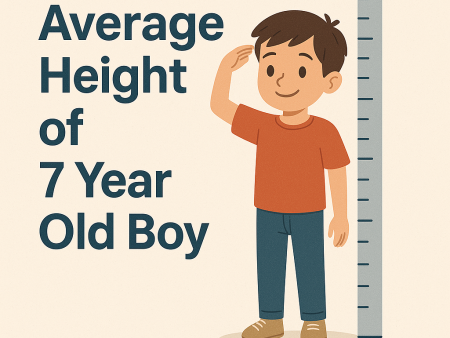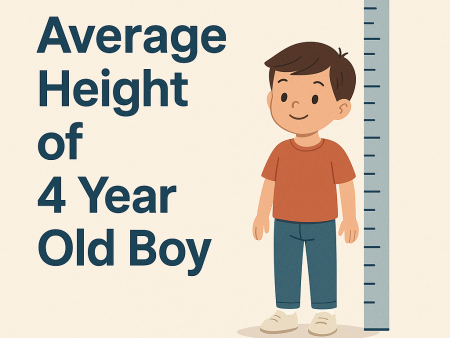Watching a child grow is one of the most exciting parts of parenting. From those first steps to their growing independence, every stage brings new milestones. For many parents, keeping track of their little one’s growth sparks curiosity about how they compare to others their age. One common question is, “What’s the average height for a 2-year-old boy?”
Understanding growth patterns can offer reass
What Is the Average Height for a 2-Year-Old Boy? Growth Milestones & Tips
Convert your height in m, cm, feet and inches to compare
0' 0" is equal to 0.0 cm or 0.00 m.
Watching a child grow is one of the most exciting parts of parenting. From those first steps to their growing independence, every stage brings new milestones. For many parents, keeping track of their little one’s growth sparks curiosity about how they compare to others their age. One common question is, “What’s the average height for a 2-year-old boy?”
Understanding growth patterns can offer reassurance and help parents recognize what’s typical during this stage. While every child grows at their own pace, having a general idea of the average height can provide helpful context. It’s important to remember that genetics, nutrition, and overall health all play a role in a child’s development.
Understanding Growth Standards For Toddlers
Growth standards for toddlers include reference points that help track physical development. The World Health Organization (WHO) and Centers for Disease Control and Prevention (CDC) provide percentile charts widely used by healthcare providers.
Percentile rankings classify a toddler’s height compared to others of the same age and gender. For example, a boy in the 50th percentile is taller than 50% of his peers.
Growth patterns depend on genetics, environment, and nutrition. Boys with taller parents or balanced diets tend to meet or exceed average height ranges. Regular check-ups allow healthcare providers to monitor growth trajectories against these standards.
Average Height For 2-Year-Old Boy
The average height for a 2-year-old boy provides a reference point for understanding typical growth at this age. Data from health organizations outlines standard ranges, considering global variations and influences on growth.
Global Statistics And Standards
According to the WHO and CDC, the average height for a 2-year-old boy is approximately 34.2 inches (86.8 cm) for the 50th percentile. A range between 33.0 inches (83.8 cm) at the 25th percentile and 35.4 inches (89.9 cm) at the 75th percentile is also considered normal. Regional differences and ethnic backgrounds may cause variations within these statistics.
Factors Influencing Height
Multiple factors affect a 2-year-old boy’s height:
- Genetics: The height of parents largely influences a child’s potential growth.
- Nutrition: Proper intake of proteins, vitamins, and minerals supports bone development.
- Health Conditions: Chronic illnesses or growth disorders can impact normal growth patterns.
- Environment: Access to healthcare and sanitation plays a role in supporting physical development.
Regular monitoring of height alongside these factors ensures accurate growth assessments.
How To Monitor Your Toddler’s Growth
Monitoring a toddler’s growth helps identify potential issues and ensures they are on a healthy development path. Parents can use tools and professional guidance to keep track of height and other growth metrics effectively.
Tools And Methods For Tracking
Growth charts and apps offer reliable ways to track height, weight, and head circumference over time. WHO and CDC growth percentile charts are widely used to compare a child’s measurements to standardized age and gender benchmarks. A soft measuring tape provides accurate height readings, ideally with the toddler standing straight against a wall. Growth chart apps let parents log data, visualize trends, and set reminders for updates.
Regular well-child visits allow healthcare providers to measure and record a toddler’s growth. Pediatricians interpret the data within the context of the child’s overall health and growth history, providing insights parents might not notice.
When To Consult A Pediatrician
Consult a pediatrician if a toddler’s height falls significantly below the 3rd percentile or shows an abrupt slowdown in growth. Irregular patterns, such as crossing major growth percentiles downward, could indicate underlying issues. Conditions like hormone imbalances, nutritional deficiencies, or chronic illnesses might contribute to deviations.
Frequent monitoring is essential if genetics or health history suggest a predisposition to growth challenges. A pediatrician can recommend tests or treatments to address specific concerns.
Supporting Healthy Growth In Toddlers
Healthy growth in toddlers requires attentive care and attention to several key factors. Nutrition, physical activity, and sleep play significant roles in ensuring optimal development.
Importance Of Nutrition
Nutrition directly impacts a toddler’s growth and overall health. Balanced diets with essential nutrients, including proteins, calcium, vitamins A and D, and iron, are crucial. For example, fruits, vegetables, dairy products, lean meats, and fortified cereals provide the necessary elements for bone growth and cell development. Inadequate nutrition may result in slower growth, while over-reliance on processed foods can lead to deficiencies.
Proper hydration is also essential. Toddlers need sufficient water intake daily to aid nutrient transportation and maintain bodily functions. If specific dietary needs or allergies exist, consulting a pediatric nutritionist can help develop suitable meal plans.
Role Of Physical Activity And Sleep
Physical activity supports bone strength, muscle development, and motor skills in toddlers. Activities like running, jumping, climbing, and playing contribute to healthy growth. According to the WHO, toddlers should be encouraged to engage in at least 180 minutes of various physical activities spread throughout the day, including moderate-to-vigorous movement.
Sleep is equally vital for growth, as essential hormones like human growth hormone (HGH) are released during deep sleep. Toddlers should aim for 11–14 hours of sleep daily, including naps. Consistent bedtime routines create a predictable schedule, encouraging better sleep quality. If issues with sleep persist, pediatricians can offer guidance.
Conclusion
Understanding the average height for a 2-year-old boy provides helpful context, but it’s important to remember that every child grows at their own pace. By focusing on proper nutrition, regular physical activity, and quality sleep, parents can support their toddler’s healthy development.
Tracking growth through tools like percentile charts and regular check-ups ensures any concerns are addressed early. If there are noticeable changes or growth falls outside typical ranges, consulting a pediatrician is always a good step. Nurturing a child’s well-being creates the foundation for their growth and future milestones.
Frequently Asked Questions
What is the average height of a 2-year-old boy?
The average height of a 2-year-old boy in the 50th percentile is approximately 34.2 inches (86.8 cm). However, a normal range falls between 33.0 inches (83.8 cm) at the 25th percentile and 35.4 inches (89.9 cm) at the 75th percentile.
What factors influence a toddler’s height?
A toddler’s height is influenced by genetics, nutrition, overall health, and environment. Children with taller parents, balanced diets, and active lifestyles typically meet or exceed the average height for their age.
Should I worry if my child is shorter than their peers?
Not necessarily. Children grow at their own pace, and being shorter may still be normal. However, if your toddler’s height is significantly below the 3rd percentile or growth patterns change abruptly, consult a pediatrician.
How often should I track my toddler’s growth?
It’s ideal to track your toddler’s growth during routine well-child visits with a pediatrician. These visits help monitor height, weight, and other development metrics against standard growth charts.
What are growth percentile charts?
Growth percentile charts, like those from the WHO or CDC, compare your child’s measurements to peers of the same age and gender. A child in the 50th percentile is taller than 50% of others.
Can nutrition impact my toddler’s growth?
Yes, nutrition plays a vital role in growth. A balanced diet with essential nutrients like protein, calcium, vitamins, and iron is crucial. Proper hydration also supports nutrient absorption and overall development.
How much physical activity does a toddler need?
Toddlers need at least 180 minutes of activity daily, including running, climbing, and other movements that support bone strength, motor skills, and overall health.
How does sleep affect toddler growth?
Sleep is essential for growth and development. Toddlers should get 11–14 hours of sleep daily, including naps. A consistent bedtime routine supports better sleep quality.
What should I do if I notice abnormal growth patterns?
If you notice abrupt growth changes or your toddler consistently falls below the 3rd percentile, consult a pediatrician. Early intervention can address potential health concerns.
Do genetics determine my toddler’s final height?
Genetics play a significant role in determining height. However, factors like nutrition, health, and environment also influence a child’s development and final growth potential.
Are there regional differences in toddler growth milestones?
Yes, regional and ethnic differences can impact growth patterns. These variations are often influenced by genetics, diet, and environmental factors specific to certain populations.





